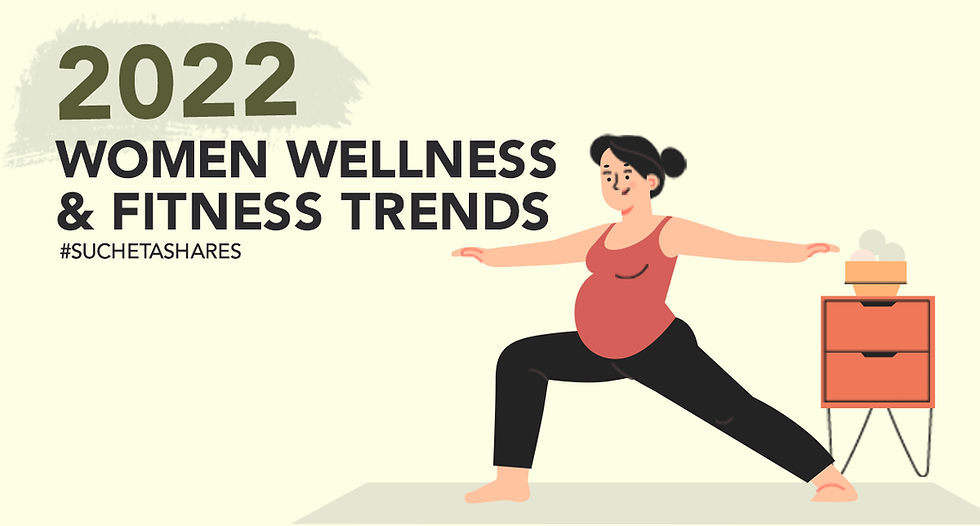Post-baby body changes no one tells you about? And what to do about it
- suchetapalofficial
- Sep 6, 2021
- 3 min read

As a first time mom-to-be last year my ideas of a postpartum body were all driven by the hundreds of articles on " how to bounce back" on the internet. But the reality of what a postpartum body really looks (and feels) like hit me like a deer caught in headlights. It was not only absolutely opposite to all the miraculous flat belly pictures that I saw of women at just 3 months postpartum but no one was talking about how regressive it was to put a societal pressure on women to bounce back when their bodies had to completely change to create a universe. It was time to change the dialogue. But if I had to, I needed to be first empowered with the knowledge of what really changed in my post-baby body. The obvious next step was to get myself certified as a pre-postnatal specialist and start the Mom.Bod.Strong initiative. So it's time we started some real talk around "Real Mom Bods"
Here are the post-baby body changes no one tells you about? And what to do about it
Firstly yes, it's crucial that we have doctors' permission before starting out on exercise post delivery but it should not be interpreted to mean that you can or should start lifting weights immediately, run or take part in intense cardio. It really just relates to light walking and rehabilitative exercises to restore strength and function to the deep core stability system (focussing on Transverse Abdominal (TA) and Pelvic Floor muscles) under the guidance of a postnatal specialist. Unlike popular belief our body is not miraculously ready to resume exercising once the doctor gives the go ahead at the 4 or 6 week check up
Secondly, post-baby urinary incontinence is a real thing and 1 out of 3 new moms will have their quality of life affected due to it. And kegels (exercises where you pretend you have to pee and then hold it) aren’t enough. It’s normal to pee when you laugh, cough, sneeze, jump, and run postpartum, but you don't have to live with it. Your pelvic floor needs to be able to lengthen & relax and also contract — not just contract. If the pelvic floor is always in a contracted state, the muscles become shortened, tightened, and sometimes weak. And it doesn't help in the recovery process. Thus kegels alone are not the answer. Instead, practicing proper activation and release of these muscles with the technique of connection breath/ diaphragmatic breathing is the key. We focus a lot on this as part of the Mom.Bod.Strong postpartum program.
Most probably you have a condition called Diastasis recti which is the partial or complete separation of the rectus abdominis, or “six-pack” muscles, which meet at the midline of your stomach. Diastasis recti is very common during and following pregnancy. This is because the uterus stretches the muscles in the abdomen to accommodate your growing baby.
Diastasis recti is what we popularly see externally as the post-baby belly.
But don't get disheartened with the flat belly before and after pictures of women on social media within weeks of childbirth. Every woman's body is different and so is recovery time. It can take anywhere from 6 week, 6 months or even a few years before you see improvements. What we need to understand is the reason behind it. If left untreated, diastasis recti can potentially lead to poor core stabilization, pelvic floor dysfunction, and back or pelvic pain. And ofcourse the external effect is the post-baby belly. And no crunches, planks, leg lifts, and bicycles can cause an increase in intra abdominal pressure and worsen diastasis recti or ab separation. The first step instead is rehabilitating the deep core with movements like the dead bug, open book, clam shell, heel slides etc.
We made an entire universe and popped it out too. So, will we be able to rebuild our “pre-pregnancy strength”? We may actually exceed it in ways we can't even imagine. The key is to lay a strong foundation with a strong core post-pregnancy.
Our body goes through a lot of changes through pregnancy, and regaining physical strength post-birth is tough but at the same time there is a new found appreciation for the body and what it is capable of.
It's not going to be easy but we need to stay on track, be patient and show grace to our body and celebrate every small win.
To know more about the Mom.Bod.Strong program visit:
https://www.suchetapalofficial.com/mom-bod-strong



Comments